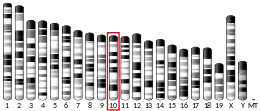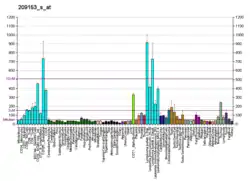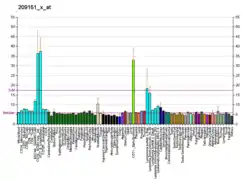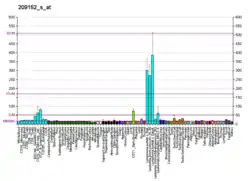Transcription factor 3 (E2A immunoglobulin enhancer-binding factors E12/E47), also known as TCF3, is a protein that in humans is encoded by the TCF3 gene.[5][6][7] TCF3 has been shown to directly enhance Hes1 (a well-known target of Notch signaling) expression.[8]
Function
This gene encodes a member of the E protein (class I) family of helix-loop-helix transcription factors. The 9aaTAD transactivation domains of E proteins and MLL are very similar and both bind to the KIX domain of general transcriptional mediator CBP.[9][10] E proteins activate transcription by binding to regulatory E-box sequences on target genes as heterodimers or homodimers, and are inhibited by heterodimerization with inhibitor of DNA-binding (class IV) helix-loop-helix proteins. E proteins play a critical role in lymphopoiesis, and the encoded protein is required for B and T lymphocyte development.[5]

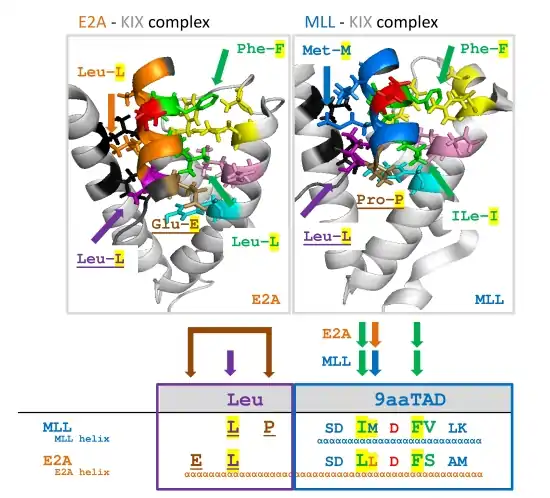
This gene regulates many developmental patterning processes such as lymphocyte and central nervous system (CNS) development. E proteins are involved in the development of lymphocytes.[11] They initiate transcription by binding to regulatory E-box sequences on target genes.
Clinical significance
Deletion of this gene or diminished activity of the encoded protein may play a role in lymphoid malignancies. This gene is also involved in several chromosomal translocations that are associated with lymphoid malignancies including pre-B-cell acute lymphoblastic leukemia (t(1;19), with PBX1 and t(17;19), with HLF),[12] childhood leukemia (t(19;19), with TFPT) and acute leukemia (t(12;19), with ZNF384).[5]
Interactions
TCF3 has been shown to interact with:
References
- 1 2 3 GRCh38: Ensembl release 89: ENSG00000071564 - Ensembl, May 2017
- 1 2 3 GRCm38: Ensembl release 89: ENSMUSG00000020167 - Ensembl, May 2017
- ↑ "Human PubMed Reference:". National Center for Biotechnology Information, U.S. National Library of Medicine.
- ↑ "Mouse PubMed Reference:". National Center for Biotechnology Information, U.S. National Library of Medicine.
- 1 2 3 "Entrez Gene: TCF3".
- ↑ Henthorn P, McCarrick-Walmsley R, Kadesch T (Feb 1990). "Sequence of the cDNA encoding ITF-1, a positive-acting transcription factor". Nucleic Acids Research. 18 (3): 677. doi:10.1093/nar/18.3.677. PMC 333499. PMID 2308859.
- ↑ Kamps MP, Murre C, Sun XH, Baltimore D (Feb 1990). "A new homeobox gene contributes the DNA binding domain of the t(1;19) translocation protein in pre-B ALL". Cell. 60 (4): 547–55. doi:10.1016/0092-8674(90)90658-2. PMID 1967983. S2CID 39661371.
- ↑ E proteins and Notch signaling cooperate to promote T cell lineage specification and commitment
- ↑ Piskacek, S (2007). "Nine-amino-acid transactivation domain: Establishment and prediction utilities". Genomics. 89 (6): 756–768. doi:10.1016/j.ygeno.2007.02.003. PMID 17467953.
- ↑ Piskacek, Martin; Vasku, A; Hajek, R; Knight, A (2015). "Shared structural features of the 9aaTAD family in complex with CBP". Mol. Biosyst. 11 (3): 844–851. doi:10.1039/c4mb00672k. PMID 25564305.
- ↑ Quong MW, Romanow WJ, Murre C (2002). "E protein function in lymphocyte development". Annual Review of Immunology. 20: 301–22. doi:10.1146/annurev.immunol.20.092501.162048. PMID 11861605.
- ↑ Herblot, Sabine; Aplan, Peter D.; Hoang, Trang (2002-02-01). "Gradient of E2A Activity in B-Cell Development". Molecular and Cellular Biology. 22 (3): 886–900. doi:10.1128/MCB.22.3.886-900.2002. ISSN 0270-7306. PMC 133542. PMID 11784864.
- 1 2 3 Goardon N, Lambert JA, Rodriguez P, Nissaire P, Herblot S, Thibault P, Dumenil D, Strouboulis J, Romeo PH, Hoang T (Jan 2006). "ETO2 coordinates cellular proliferation and differentiation during erythropoiesis". The EMBO Journal. 25 (2): 357–66. doi:10.1038/sj.emboj.7600934. PMC 1383517. PMID 16407974.
- 1 2 3 Bradney C, Hjelmeland M, Komatsu Y, Yoshida M, Yao TP, Zhuang Y (Jan 2003). "Regulation of E2A activities by histone acetyltransferases in B lymphocyte development". The Journal of Biological Chemistry. 278 (4): 2370–6. doi:10.1074/jbc.M211464200. PMID 12435739.
- ↑ Maira SM, Wurtz JM, Wasylyk B (Nov 1996). "Net (ERP/SAP2) one of the Ras-inducible TCFs, has a novel inhibitory domain with resemblance to the helix-loop-helix motif". The EMBO Journal. 15 (21): 5849–65. doi:10.1002/j.1460-2075.1996.tb00972.x. PMC 452333. PMID 8918463.
- ↑ Deed RW, Jasiok M, Norton JD (Apr 1998). "Lymphoid-specific expression of the Id3 gene in hematopoietic cells. Selective antagonism of E2A basic helix-loop-helix protein associated with Id3-induced differentiation of erythroleukemia cells". The Journal of Biological Chemistry. 273 (14): 8278–86. doi:10.1074/jbc.273.14.8278. PMID 9525934.
- 1 2 3 Langlands K, Yin X, Anand G, Prochownik EV (Aug 1997). "Differential interactions of Id proteins with basic-helix-loop-helix transcription factors". The Journal of Biological Chemistry. 272 (32): 19785–93. doi:10.1074/jbc.272.32.19785. PMID 9242638.
- ↑ Johnson JD, Zhang W, Rudnick A, Rutter WJ, German MS (Jul 1997). "Transcriptional synergy between LIM-homeodomain proteins and basic helix-loop-helix proteins: the LIM2 domain determines specificity". Molecular and Cellular Biology. 17 (7): 3488–96. doi:10.1128/mcb.17.7.3488. PMC 232202. PMID 9199284.
- ↑ Miyamoto A, Cui X, Naumovski L, Cleary ML (May 1996). "Helix-loop-helix proteins LYL1 and E2a form heterodimeric complexes with distinctive DNA-binding properties in hematolymphoid cells". Molecular and Cellular Biology. 16 (5): 2394–401. doi:10.1128/mcb.16.5.2394. PMC 231228. PMID 8628307.
- ↑ Neufeld B, Grosse-Wilde A, Hoffmeyer A, Jordan BW, Chen P, Dinev D, Ludwig S, Rapp UR (Jul 2000). "Serine/Threonine kinases 3pK and MAPK-activated protein kinase 2 interact with the basic helix-loop-helix transcription factor E47 and repress its transcriptional activity". The Journal of Biological Chemistry. 275 (27): 20239–42. doi:10.1074/jbc.C901040199. PMID 10781029.
- ↑ Maleki SJ, Royer CA, Hurlburt BK (Jun 1997). "MyoD-E12 heterodimers and MyoD-MyoD homodimers are equally stable". Biochemistry. 36 (22): 6762–7. doi:10.1021/bi970262m. PMID 9184158.
- ↑ Chakraborty T, Martin JF, Olson EN (Sep 1992). "Analysis of the oligomerization of myogenin and E2A products in vivo using a two-hybrid assay system". The Journal of Biological Chemistry. 267 (25): 17498–501. doi:10.1016/S0021-9258(19)37069-3. PMID 1325437.
- ↑ Hsu HL, Wadman I, Baer R (Apr 1994). "Formation of in vivo complexes between the TAL1 and E2A polypeptides of leukemic T cells". Proceedings of the National Academy of Sciences of the United States of America. 91 (8): 3181–5. Bibcode:1994PNAS...91.3181H. doi:10.1073/pnas.91.8.3181. PMC 43539. PMID 8159721.
- ↑ El Ghouzzi V, Legeai-Mallet L, Aresta S, Benoist C, Munnich A, de Gunzburg J, Bonaventure J (Mar 2000). "Saethre-Chotzen mutations cause TWIST protein degradation or impaired nuclear location". Human Molecular Genetics. 9 (5): 813–9. doi:10.1093/hmg/9.5.813. PMID 10749989.
- ↑ Huggins GS, Chin MT, Sibinga NE, Lee SL, Haber E, Lee ME (Oct 1999). "Characterization of the mUBC9-binding sites required for E2A protein degradation". The Journal of Biological Chemistry. 274 (40): 28690–6. doi:10.1074/jbc.274.40.28690. PMID 10497239.
Further reading
- LeBrun DP (May 2003). "E2A basic helix-loop-helix transcription factors in human leukemia". Frontiers in Bioscience. 8 (1–3): s206–22. doi:10.2741/1030. PMID 12700034.
This article incorporates text from the United States National Library of Medicine, which is in the public domain.


